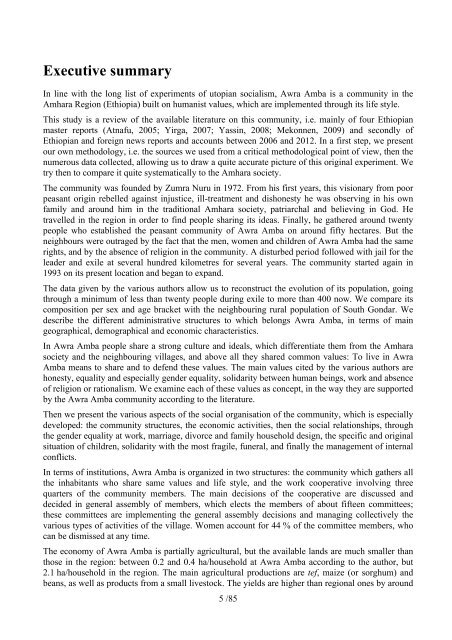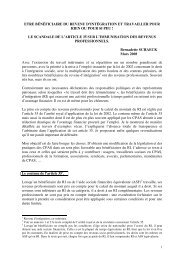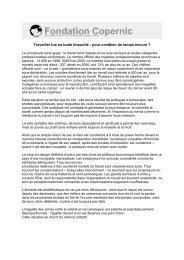Awra Amba RJ 300612 EN - Contacter un comité local d'Attac
Awra Amba RJ 300612 EN - Contacter un comité local d'Attac
Awra Amba RJ 300612 EN - Contacter un comité local d'Attac
Create successful ePaper yourself
Turn your PDF publications into a flip-book with our unique Google optimized e-Paper software.
Executive summary<br />
In line with the long list of experiments of utopian socialism, <strong>Awra</strong> <strong>Amba</strong> is a comm<strong>un</strong>ity in the<br />
Amhara Region (Ethiopia) built on humanist values, which are implemented through its life style.<br />
This study is a review of the available literature on this comm<strong>un</strong>ity, i.e. mainly of four Ethiopian<br />
master reports (Atnafu, 2005; Yirga, 2007; Yassin, 2008; Mekonnen, 2009) and secondly of<br />
Ethiopian and foreign news reports and acco<strong>un</strong>ts between 2006 and 2012. In a first step, we present<br />
our own methodology, i.e. the sources we used from a critical methodological point of view, then the<br />
numerous data collected, allowing us to draw a quite accurate picture of this original experiment. We<br />
try then to compare it quite systematically to the Amhara society.<br />
The comm<strong>un</strong>ity was fo<strong>un</strong>ded by Zumra Nuru in 1972. From his first years, this visionary from poor<br />
peasant origin rebelled against injustice, ill-treatment and dishonesty he was observing in his own<br />
family and aro<strong>un</strong>d him in the traditional Amhara society, patriarchal and believing in God. He<br />
travelled in the region in order to find people sharing its ideas. Finally, he gathered aro<strong>un</strong>d twenty<br />
people who established the peasant comm<strong>un</strong>ity of <strong>Awra</strong> <strong>Amba</strong> on aro<strong>un</strong>d fifty hectares. But the<br />
neighbours were outraged by the fact that the men, women and children of <strong>Awra</strong> <strong>Amba</strong> had the same<br />
rights, and by the absence of religion in the comm<strong>un</strong>ity. A disturbed period followed with jail for the<br />
leader and exile at several h<strong>un</strong>dred kilometres for several years. The comm<strong>un</strong>ity started again in<br />
1993 on its present location and began to expand.<br />
The data given by the various authors allow us to reconstruct the evolution of its population, going<br />
through a minimum of less than twenty people during exile to more than 400 now. We compare its<br />
composition per sex and age bracket with the neighbouring rural population of South Gondar. We<br />
describe the different administrative structures to which belongs <strong>Awra</strong> <strong>Amba</strong>, in terms of main<br />
geographical, demographical and economic characteristics.<br />
In <strong>Awra</strong> <strong>Amba</strong> people share a strong culture and ideals, which differentiate them from the Amhara<br />
society and the neighbouring villages, and above all they shared common values: To live in <strong>Awra</strong><br />
<strong>Amba</strong> means to share and to defend these values. The main values cited by the various authors are<br />
honesty, equality and especially gender equality, solidarity between human beings, work and absence<br />
of religion or rationalism. We examine each of these values as concept, in the way they are supported<br />
by the <strong>Awra</strong> <strong>Amba</strong> comm<strong>un</strong>ity according to the literature.<br />
Then we present the various aspects of the social organisation of the comm<strong>un</strong>ity, which is especially<br />
developed: the comm<strong>un</strong>ity structures, the economic activities, then the social relationships, through<br />
the gender equality at work, marriage, divorce and family household design, the specific and original<br />
situation of children, solidarity with the most fragile, f<strong>un</strong>eral, and finally the management of internal<br />
conflicts.<br />
In terms of institutions, <strong>Awra</strong> <strong>Amba</strong> is organized in two structures: the comm<strong>un</strong>ity which gathers all<br />
the inhabitants who share same values and life style, and the work cooperative involving three<br />
quarters of the comm<strong>un</strong>ity members. The main decisions of the cooperative are discussed and<br />
decided in general assembly of members, which elects the members of about fifteen committees;<br />
these committees are implementing the general assembly decisions and managing collectively the<br />
various types of activities of the village. Women acco<strong>un</strong>t for 44 % of the committee members, who<br />
can be dismissed at any time.<br />
The economy of <strong>Awra</strong> <strong>Amba</strong> is partially agricultural, but the available lands are much smaller than<br />
those in the region: between 0.2 and 0.4 ha/household at <strong>Awra</strong> <strong>Amba</strong> according to the author, but<br />
2.1 ha/household in the region. The main agricultural productions are tef, maize (or sorghum) and<br />
beans, as well as products from a small livestock. The yields are higher than regional ones by aro<strong>un</strong>d<br />
5 /85

















